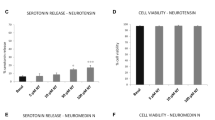Abstract
MCD-peptide and its modified analogues have been tested for their histamine-releasing activity on mast cells and for the ability to inhibit vascular permeability in rat's skin. Reduction of disulphide bonds, modification of the basic lysine ɛ-NH2 groups and histidines in MCD-peptide suppressed its histamine-releasing action. Modification of the basic arginine guanidino groups did not alter this activity. MCD-peptide inhibited the vascular permeability induced by histamine and serotonin. Modification of MCD-peptide lysines and arginines abolished the inhibiting activity.
Similar content being viewed by others
References
I.S. Gushchin, A.I. Miroshnikov, andV.I. Martynov,Features Peculiar to the Histamine-Releasing Action of MCD-Peptide from the Apis mellifica Venom, Bull. exp. Biol. (USSR)83, 78–80 (1977).
B.E. Banks, F.D. Rumjanek, N.H. Sinelair andCh.A. Vernon,Possible Therapeutic Use of a Peptide from Bee Venom, Bull. Inst. Pasteur74, 137–144 (1976).
J.M. Hanson, J. Morley andC. Seria-Herrera,Antiinflammatory Property of 401 (MCD-Peptide), a Peptide from the Venom of the Bee Apis mellifera (L), Br. J. Pharmac.50, 383–392 (1974).
B. Uvnäs andI. Thon,Isolation of ‘Biologically Intact’ Mast Cells, Exp. Cell Res.18, 512–520 (1959).
A. Bergendorff andB. Uvnäs,Storage of 5-Hydroxytryptamine in Rat Mast Cells. Evidence for an Ionic Binding to Carboxyl Groups in a Granule Heparin-Protein Complex, Acta physiol. Scand.84, 320–331 (1972).
J. Gauldie, J.M. Hanson, F.D. Rumjanek andCh.A. Vernon,The Peptide Components of Bee Venom, Eur. J. Biochem.61, 369–376 (1976).
A.I. Miroshnikov, E.G. Elyakova, A.B. Kudelin andL.B. Senyavina,Physico-Chemical Characteristics of Apamin, a Neurotoxin from Honeybee Apis mellifica, Bioorg. Khim. (Russian)4, 1022–1028 (1978).
A.R. Nuruddinov, E.G. Elyakova, V.P. Mal'kova, V.I. Tsetlin andV.T. Ivanov,Apamin Reduction-Reoxidation and Its Interaction with Liquid HF, Bioorg. Khim. (Russian)4, 1314–1321 (1978).
I.S. Gushchin, N.L. Bogush andV.V. Sviridov,In vitro and in vivo Inhibition of Anaphylactic Reactions with 1-Methyl-3-Isobutyl Xanthine, Bull. Exp. Biol. (USSR)83, 443–446 (1977).
B.E. Banks, A.J. Garmar andE. Habermann,Structure-Activity Studies on Apamin and Mast Cell Degranulating Peptide (MCD-Peptide)-401. J. Physiol. (London)284, 160–161P (1978).
Author information
Authors and Affiliations
Rights and permissions
About this article
Cite this article
Gushchin, I.S., Miroshnikov, A.I., Martynov, V.I. et al. Histamine releasing and anti-inflammatory activities of MCD-peptide and its modified forms. Agents and Actions 11, 69–71 (1981). https://doi.org/10.1007/BF01991459
Issue Date:
DOI: https://doi.org/10.1007/BF01991459




